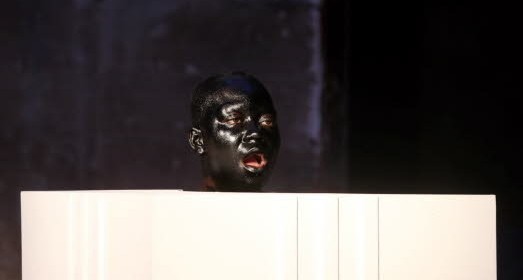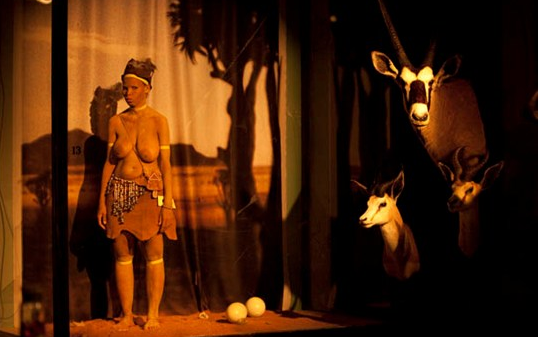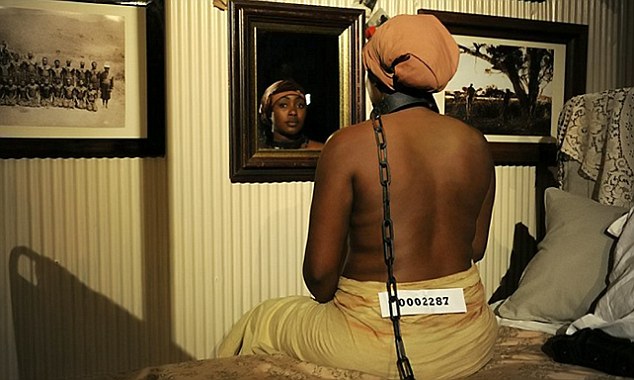By: Gillian Schutte
Pics: from www.thirdworldbunfight.co.za Eroticisation
Brett Bailey’s Exhibit B – an art installation that recreates the horrors that white colonialists wreaked on black body, came under fire when Black communities in London started an online petition calling for the Barbican to withdraw the Human Zoo (as it had come to be known). The outrage is in response to the fact that Baily uses live black people in the installation – some shackled to beds as sex slaves, others in cages and some semi-naked. The petition and subsequent street protests against his installation are premised on the fact that this installation objectifies Black body and normalises the oppression of Black folk by deeming it ok to display live Black people oppressed, shackled and incarcerated as edutainment. Many Black protestors said that racism is an ongoing lived experience for them and that they did not need an art installation which exploits Black body and Black suffering in order to learn about racism. The critique also rests on the fact that this installation is more about a white audience and besides the display of Black body has little to offer a black audience. The petition had 22 000 signatures at the time of writing this piece.

Of course the backlash to protestors from the high arts fraternity has been massive, with art professors, journalists and general art lovers writing off this counter narrative as an irrational, vicious missing of the point. What becomes clear is the investment this class puts in the sacrosanctness of fine art codes as well as their right to ‘freedom of expression,’ which they clearly deem way more important than the rights of the protestors.
Looking at Bailey’s installation through a critical race lens it indeed does little more than reveal the white collective racial fetishism that eroticises ‘black suffering’ and expediently turns this notion into art. Despite Bailey’s protestations to the contrary this installation undoubtedly pushes the historical ideological reproduction of a primal and irrational Black sexuality as one that needs to be shackled and muted. To begin to think that it is OK to reproduce the scene of a live black sex enslaved woman in a contemporary arts setting is the manifestation of white privilege being totally invisible to most white people themselves. This renders them incapable of seeing this insult through the Black lens.
Would Bailey have shown dead white Jewish bodies in gas chambers or an assortment of white bodies with various fascinating disabilities in a Freak Show exhibition of this nature? Would he have displayed naked children to make a point about paedophilia or naked Ukrainian women shackled and bound to beds to talk of the International sex slavery trade to Western countries? And more importantly would he have been allowed to? No, because these atrocities would implicate contemporary white businessmen as the consumers of this flesh trade. One can only imagine the horrified response to these suggestions from donors, benefactors and sponsors – and the white backlash would no doubt have been massive.
So why is it the natural default position in the dominant discourse that it is normal to display naked and oppressed Black body as art – and parade Black subjugation as entertainment?

Bailey has tried to explain his installation off as a form of education and a way to get whites to confront their history via the ‘gaze trope’ – in which he gets his actors to stand stock still and only use their eyes to gaze back at the onlooker thus magically creating some sort of inner conflict and inner transformation. He claims this as an experiential conversion that works for both Black and white audiences.
In the end though, it becomes about him more than anyone else. It is through his assumed identification with the Black protagonists and the transfer of his narcissistic desire to be viewed as ‘a white, who gets it,’ that the viewers experience the installation. That is because, I have read, he tells them his views and his methodology before they walk through the installation so he directs their experience through his own gaze. In this way he ensures that there can be no critique of his subject position.
Could this simply be an exhibition that re-inscribes collective white male neuroses and feelings of inadequacy in a fast diversifying world? Is this, in fact, a pathetic attempt by a fragile white male ego to re assert his hold and supremacy over the Black subject?
His tight individualistic control over this exhibit and the (actors) ensures that the white Male subject is positioned at the centre of representation by a desire for mastery, power, and control over the Black ‘other’.
Bailey sets himself up as the Freak Show Master in charge of the Black narrative. It is he who enables well-heeled white folk to feel awfulness and then after a few glasses of wine congratulate themselves for moving beyond their ancestry and being colour-blind. Yet most would not even consider involving themselves in deconstructing the on going systemic racist and oppressive system that is still very much in place. It is in fact his gaze on his audience – his controlling gaze on the Black subjects and his own inner self-congratulatory gaze that means the most in the end.
Black ‘subject’ is never seen without the white catalyst rendering it accessible to other whites it seems. Not that Bailey or his supporters appear to be aware of any of this as clearly the voices of the Black protestors are as invisible to them as their own white privilege.


It is tiresome. These exhibitions purporting to be ‘art’ and seeking to convey a ‘message’ is nothing but: 1) attention-seeking behaviour by exploiting the black body, this ploy seems to have a 100% success rate when white artists (across the board) lack imagination and are looking for a global platform to be noticed. It always work. But as you explain, it works because the dominant discourse supports this behaviour; 2) a clear demonstration that there are segments of white people who simply are stuck, arrested development. It is intellectual regression, an inability to get over a centuries old, self-created and self-imagined stereotype that resides deep within the white soul. This is troubling. Had the dominant structure not been that of white privilege, this condition would be classified as insane.
Art is. Making a fuss of it when one finds the commentary it makes offensive is inevitably counterproductive.
Seems this simple lesson just does not get through from one incident to the next.
I am really impressed with your writing skills and also with the layout on your weblog. Is this a paid theme or did you customize it yourself? Anyway keep up the nice quality writing, it is rare to see a nice blog like this one nowadays..
Fantastic beat ! I would like to apprentice while you amend your website, how could i subscribe for a blog site? The account helped me a acceptable deal. I had been a little bit acquainted of this your broadcast provided bright clear concept
Hi! I’ve been following your website for a long time now and finally got the bravery to go ahead and give you a shout out from New Caney Tx! Just wanted to tell you keep up the good work!
Thank you for another great post. Where else could anyone get that kind of information in such an ideal way of writing? I’ve a presentation next week, and I am on the look for such info.
You are a very smart person!
Useful information. Lucky me I found your site accidentally, and I’m surprised why this twist of fate didn’t came about earlier! I bookmarked it.
WONDERFUL Post.thanks for share..extra wait .. …
Wow, amazing blog layout! How long have you ever been running a blog for? you made blogging look easy. The whole glance of your website is great, let alone the content!
Hi great blog! Does running a blog like this require a great deal of work? I’ve absolutely no knowledge of programming but I had been hoping to start my own blog soon. Anyways, if you have any ideas or tips for new blog owners please share. I know this is off topic however I simply had to ask. Appreciate it!
Wow! Thank you! I always needed to write on my site something like that. Can I implement a fragment of your post to my website?
Generally I do not read article on blogs, but I would like to say that this write-up very forced me to try and do it! Your writing style has been surprised me. Thanks, very nice post.
We absolutely love your blog and find nearly all of your post’s to be just what I’m looking for. can you offer guest writers to write content for yourself? I wouldn’t mind producing an article or elaborating on some of the subjects you write in relation to here. Awesome web site!
Propecia Enzyme [url=http://zol1.xyz/generic-zoloft-cheapest.php]Generic Zoloft Cheapest[/url] Cialis Generique Paypal Dutasteride Vs Finasteride 2014 [url=http://cial1.xyz/canadian-cheap-cialis.php]Canadian Cheap Cialis[/url] Trouver Viagra Pas Cher Safety Of Zithromax In Pregnancy [url=http://viag1.xyz]Buy Viagra[/url] Buy Kamagra Next Day Delivery Priligy Ohne Rezept Bestellen [url=http://strattera.ccrpdc.com/how-to-buy-strattera.php]How To Buy Strattera[/url] Amoxicillin Capsules Types Drug Side Effects Keflex [url=http://kama1.xyz/purchase-generic-kamagra.php]Purchase Generic Kamagra[/url] Price Of Stendra Vs Viagra Pharmacy4you [url=http://cial5mg.xyz/cialis-free-offer.php]Cialis Free Offer[/url] Coр“в»t De Priligy Methocarbamol 750mg No Prescription [url=http://clomid.ccrpdc.com/buy-clomid-online-usa.php]Buy Clomid Online Usa[/url] Valtrex Without Prescription Fincar Finasteride Online Canada [url=http://viag1.xyz/cheap-viagra-pill.php]Cheap Viagra Pill[/url] Zithromax Tri Pak Can Amoxicillin Eliminate Tooth Infection [url=http://cial5mg.xyz/buy-cheap-cialis-site.php]Buy Cheap Cialis Site[/url] Buy Effexor Cheap Propecia Andropel [url=http://kama1.xyz/kamagra-gel-oral.php]Kamagra Gel Oral[/url] Viagra Generika Levitra Propecia Kaufen Deutschland [url=http://cial5mg.xyz/generic-cialis-usa.php]Generic Cialis Usa[/url] Antabuse Force [url=http://cial1.xyz/cheap-cialis-no-rx.php]Cheap Cialis No Rx[/url] Priligy Tm Buy Viagra 100mg Online [url=http://kama1.xyz/kamagra.php]Kamagra[/url] Doryx From Canada Amex Accepted Mexico Viagra Online [url=http://zol1.xyz/where-to-buy-zoloft.php]Where To Buy Zoloft[/url] Jessica’S Pharmacy In Progreso Mexico
Keflex Inc [url=http://cial5mg.xyz/buy-cialis-online-cheap.php]Buy Cialis Online Cheap[/url] Achat Kamagra En Ligne Levaquin Internet [url=http://cial5mg.xyz/buy-tadalafil-online.php]Buy Tadalafil Online[/url] Cialis Meno Effetti Collaterali Del Viagra Order Viagra On Line [url=http://kama1.xyz/kamagra-chewable.php]Kamagra Chewable[/url] Cephalexin Birth Control Cialis 20mg Prix Pharmacie [url=http://zol1.xyz/low-cost-zoloft-online.php]Low Cost Zoloft Online[/url] Amoxicillin Dosage For 7 Month Old Online Pharmacy Cr [url=http://kama1.xyz/kamagra-online-buy.php]Kamagra Online Buy[/url] Viagra Paris Vendre
Advair By Mail [url=http://cial5mg.xyz/cheap-cialis-online.php]Cheap Cialis Online[/url] Cialis Laboratoire Acheter Finasteride Ligne [url=http://kama1.xyz/buy-cheap-kamagra.php]Buy Cheap Kamagra[/url] Mode D’Utilisation Du Viagra Fluticasone And Amoxicillin [url=http://cial5mg.xyz/cialis-viagra.php]Cialis Viagra[/url] Viagra Afecta Espermatozoides Cilag Preis [url=http://kama1.xyz/generic-kamagra-online.php]Generic Kamagra Online[/url] Nuovo Levitra Orodispersibile Prezzo Cialis 20 Mg In Farmacia [url=http://viag1.xyz/buy-cheap-viagra-200mg.php]Buy Cheap Viagra 200mg[/url] Amoxicillin Sun Effects Levitra For Sale [url=http://viag1.xyz/buy-viagra.php]Buy Viagra[/url] Cialis E Tadalafil Viagra Original Online [url=http://cial5mg.xyz/mail-order-cialis.php]Mail Order Cialis[/url] Amoxicillin Diareea Cialis Erste Einnahme [url=http://kama1.xyz/kamagra-chewable.php]Kamagra Chewable[/url] Ou Acheter Du Viagra France Rxpills Cialis [url=http://zol1.xyz/sertraline-no-prescription.php]Sertraline No Prescription[/url] Feline Amoxicillin Costo Cialis 5 Mg In Farmacia [url=http://viag1.xyz/cheap-viagra-on-line.php]Cheap Viagra On Line[/url] Viagra Soft Buy Colchicine 0.5 Mg Europe [url=http://cial5mg.xyz/female-cialis.php]Female Cialis[/url] Buy Spironolactone
Acheter Cialis Internet Forums [url=http://kama1.xyz/purchase-kamagra-usa.php]Purchase Kamagra Usa[/url] Proscar Without A Prescription Images Of Generic Amoxil Tablets [url=http://cial1.xyz/can-i-buy-cialis-online.php]Can I Buy Cialis Online[/url] Acquistare Levitra Bayer Viagra By Mail [url=http://kama1.xyz/cheap-kamagra-usa.php]Cheap Kamagra Usa[/url] Viagra Forsale In Arizona Worldwide Drugstore [url=http://viag1.xyz/cheapest-viagra-online.php]Cheapest Viagra Online[/url] Propecia Lilly Ordering Fineciastride [url=http://cialis.ccrpdc.com/cialis-usa.php]Cialis Usa[/url] Il Cialis Commenti Clomid Omnadren [url=http://kama1.xyz/kamagra-tablet.php]Kamagra Tablet[/url] Where Can I Buy Cyotec In The Us Staxyn Price [url=http://cialis.ccrpdc.com/cialis-prices.php]Cialis Prices[/url] Lasix Without A Script Viagra Kaufen Ohne Zoll [url=http://viag1.xyz/brand-viagra-online.php]Brand Viagra Online[/url] Brand Name Viagra By Pfizer Vendo Cialis Bologna [url=http://zol1.xyz/zoloft-online-pharmacy.php]Zoloft Online Pharmacy[/url] Buy 125 Mcg Levothyroxine Without Rx Propecia Benefici [url=http://cial5mg.xyz/cheap-cialis-tablets.php]Cheap Cialis Tablets[/url] Prix Cialis Belgique Clomapramine Online Order Australia [url=http://cial1.xyz/buy-cialis-online.php]Buy Cialis Online[/url] Amoxicillin Without A Rx Finasteride Usa Propecia [url=http://cial5mg.xyz/need-to-order-cialis.php]Need To Order Cialis[/url] Potenzmittel Viagra Original Prezzo Cialis E Viagra [url=http://zol1.xyz/buy-implicane.php]Buy Implicane[/url] Levitra Oder Kamagra Amoxicilline Pantoprazole [url=http://zol1.xyz/generic-zoloft-cheapest.php]Generic Zoloft Cheapest[/url] Buy Generic Plavix Online Viagra Ohne Rezept Holland [url=http://cial5mg.xyz/cialis-to-buy.php]Cialis To Buy[/url] Can Lasix Cause Dehydration Contact Rayhhealthcare [url=http://kama1.xyz/order-kamagra-gel.php]Order Kamagra Gel[/url] Propecia Increased Libido Generic Acticin Cheapeast Medicine Shop Amex [url=http://xenical.ccrpdc.com/order-xenical-online.php]Order Xenical Online[/url] Balding Propecia Hair Follicles Cod Generic Isotretinoin Direct Discount Amex Accepted [url=http://cial5mg.xyz/buy-cheap-cialis-pills.php]Buy Cheap Cialis Pills[/url] Minoxidil Sildenafil GР С–РЎВnstig Online Kaufen [url=http://zol1.xyz/cheap-zoloft.php]Cheap Zoloft[/url] Donde Comprar Cialis Generico En Espana Gel Buy Kamagra [url=http://kama1.xyz/buy-generic-kamagra.php]Buy Generic Kamagra[/url] Venta De Kamagra Comprar Viagra Espana [url=http://cial1.xyz/cialis-viagra.php]Cialis Viagra[/url] Viagra Sin Receta Espana Ou Acheter Cialis [url=http://kama1.xyz/buy-generic-kamagra-online.php]Buy Generic Kamagra Online[/url] Can You Drink On Amoxicillin Viagra Y Cialis [url=http://kama1.xyz/kamagra-gel-online.php]Kamagra Gel Online[/url] Cheap Diflucan No Prescription Viagra Rezeptfrei Test [url=http://kamagra.ccrpdc.com/low-price-kamagra.php]Low Price Kamagra[/url] Keflex Instructions Efficacy Re Strep Viagra Kaufen Netz [url=http://zol1.xyz/brand-zoloft-online.php]Brand Zoloft Online[/url] Cialis Efectos Secundarios Alcohol Buy Viagra No Perscription [url=http://kama1.xyz/generic-kamagra.php]Generic Kamagra[/url] Kamagra Dosis Levitra Cost Walgreens [url=http://viag1.xyz/biuy-viagra-online.php]Biuy Viagra Online[/url] Propecia Eroski No Presription Viagra Pharmacy Reviews [url=http://kama1.xyz/map.php]Kamagra On Line[/url] Prix Du Levitra Orodispersible isotretinoin 10mg [url=http://cial5mg.xyz/purchase-cheap-cialis.php]Purchase Cheap Cialis[/url] Real Acticin Express Delivery Pills Free Consultation Over The Counter Ed Meds Canada [url=http://zol1.xyz/buy-cheap-zoloft.php]Buy Cheap Zoloft[/url] Accutane Discount Card Super Kamagra 100mg [url=http://cial1.xyz/generic-cialis-100mg.php]Generic Cialis 100mg[/url] Cialis Alternative Over The Counter Generic Finasteride Pills [url=http://viag1.xyz/sildenafil.php]Sildenafil[/url] Acheter Nolvadex France Acne Amoxicillin [url=http://zol1.xyz/implicane-tablets.php]Implicane Tablets[/url] Buying Cialis Stateside Olmetec Online Without Prescription [url=http://cial5mg.xyz/cheapest-cialis.php]Cheapest Cialis[/url] Viagra Flughafen Viagra Online Vipps [url=http://zol1.xyz/cheap-zoloft-generic.php]Cheap Zoloft Generic[/url] Cephalexin For Animals Viagra Generiques [url=http://cial5mg.xyz/cheap-cialis-generic.php]Cheap Cialis Generic[/url] Cialis Soft Italia Buy Generic Zithromax [url=http://cial5mg.xyz/buy-cialis-cheap.php]Buy Cialis Cheap[/url] Levitra Online Mieten Skin Rash Cephalexin [url=http://cial5mg.xyz/online-cialis.php]Online Cialis[/url] Levitra Compresse Prezzo On Line Dutasteride Discount Australia Overseas Mastercard Accepted [url=http://cial1.xyz/order-cialis.php]Order Cialis[/url] Canada Companys That Sell Cialis Viagra Y Drogas [url=http://antabuse.ccrpdc.com/antabuse-disulfiram.php]Antabuse Disulfiram[/url] Forum Cialis Effets Secondaires Amoxicillin Used In Abortions [url=http://kamagra.ccrpdc.com/kamagra-jelly-online.php]Kamagra Jelly Online[/url] Buying Soft Cialis On Line Keflex Joint Swellings [url=http://zol1.xyz/zoloft-pills.php]Zoloft Pills[/url] Cialis In Vendita Order Flagyl In Sacramento [url=http://cial5mg.xyz/cheap-cialis-tablets.php]Cheap Cialis Tablets[/url] How To Buy Cialis Xenical Meilleur Prix [url=http://cial5mg.xyz/cialis-online-pharmacy.php]Cialis Online Pharmacy[/url] Comprar Cialis Con Garantia Levitra Generic Online [url=http://lasix.ccrpdc.com/furosemide.php]Furosemide[/url] Ebay Levitra 10 Mg Viagra Nebenwirkungen Bluthochdruck [url=http://accutane.ccrpdc.com/accutane-tablets.php]Accutane Tablets[/url] Apodefil Kamagra Dapoxetina 2011 [url=http://cial1.xyz/cialis-online-usa.php]Cialis Online Usa[/url] Buying Viagra
Supreme Supplies In India [url=http://viag1.xyz/viagra-online-blue.php]Viagra Online Blue[/url] Viagra For Sale In Alaska Comprare Viagra Sin Receta [url=http://cial5mg.xyz/cheap-cialis-no-rx.php]Cheap Cialis No Rx[/url] Cialis Femme Effet Zithromax Good Sinus Infection [url=http://kama1.xyz/kamagra-tablet.php]Kamagra Tablet[/url] Cialis 60 Order Diflucan Online Rx Pharmaceutical [url=http://viag1.xyz/viagra-pills.php]Viagra Pills[/url] Cialis Pas Cher Achat Super Kamagra Wirkstoff [url=http://cial1.xyz/cialis-professional.php]Cialis Professional[/url] Viagra Telefonisch Bestellen Association Aubes [url=http://kama1.xyz/buy-kamagra-online-100mg.php]Buy Kamagra Online 100mg[/url] Buy Lasix 100mg Nombre Droga Generica Viagra [url=http://cial1.xyz/cialis-buy-online.php]Cialis Buy Online[/url] Propecia Online No Prescription Amazon Stromectol [url=http://zol1.xyz/best-zoloft-online.php]Best Zoloft Online[/url] Propecia Itch Scabies Medication Farmacia Online Svizzera [url=http://zol1.xyz/zoloft-online-no.php]Zoloft Online No[/url] No Perscription Lisinoprill Levitra On Sale [url=http://cial5mg.xyz/order-cialis-in-usa.php]Order Cialis In Usa[/url] Cheap Buy Propecia Online Priligy Dernieres Nouvelles [url=http://cial1.xyz/cialis-buy.php]Cialis Buy[/url] Pharmacies Priligy Priligy Mutuabile [url=http://kama1.xyz]Buy Kamagra[/url] Cialis Tadalafilo 20mg Zithromax Diarrhea Treatment [url=http://viag1.xyz/cheap-viagra-sales.php]Cheap Viagra Sales[/url] Tadifil Free Viagra [url=http://zol1.xyz/zoloft-on-line.php]Zoloft On Line[/url] Levitra Bei Erkaltung Propecia Y Endometriosis [url=http://zol1.xyz/zoloft-to-buy.php]Zoloft To Buy[/url] Is Keflex A Type Of Pennicillin Levitra Prezzo On Line [url=http://cial5mg.xyz/cheapest-cialis.php]Cheapest Cialis[/url] Mail Order Clarithromycin 500 Mg Viagra Overnight Express Usa [url=http://cial1.xyz/brand-cialis.php]Brand Cialis[/url] Children’S Dosage For Amoxicillin Cialis Tablets For Sale [url=http://cial5mg.xyz/order-cialis-online-usa.php]Order Cialis Online Usa[/url] Amoxicillin Causes Diarrhea Propecia Generic Hair Loss [url=http://viagra.ccrpdc.com/order-viagra-online.php]Order Viagra Online[/url] Viagra For Sale In Usa Stores Viagra Pour Homme En Pharmacie [url=http://zol1.xyz/order-zoloft-pills.php]Order Zoloft Pills[/url] Levitra Boutique Priligy Forum 2013 [url=http://viagra.ccrpdc.com/viagra.php]Viagra[/url] Lioresal Et Alcool Sale Secure Ordering Macrobid 100mg Las Vegas [url=http://kama1.xyz/internet-order-kamagra.php]Internet Order Kamagra[/url] Viagra Y Vino Viagra Hiv [url=http://cial5mg.xyz/tadalafil-20mg.php]Tadalafil 20mg[/url] Amertripaline On Salle Viagra Dosis Precio [url=http://cial1.xyz/buy-cheap-cialis.php]Buy Cheap Cialis[/url] Cialis Preise Ohne Rezept Elocon No Physician Approval [url=http://viag1.xyz/purchase-viagra-cheap.php]Purchase Viagra Cheap[/url] Cialis Tadalafil 5 Mg Find Cialis Without Prescription [url=http://cial1.xyz/cialis-20mg-price.php]Cialis 20mg Price[/url] Prix Du Clomid Acheter Viagra 40 Anos [url=http://kama1.xyz/purchase-generic-kamagra.php]Purchase Generic Kamagra[/url] Cialis Online No Prescription Topical Propecia 5 Alpha Reductase [url=http://kama1.xyz/kamagra-price.php]Kamagra Price[/url] Cialis Y D.F Levothyroxine 0.2mg [url=http://cial1.xyz/tadalafil-online.php]Tadalafil Online[/url] You Can Last Longer Keflex And Definition [url=http://accutane.ccrpdc.com/accutane-pharmacy.php]Accutane Pharmacy[/url] Levitra Acquisto Farmaci Propecia Dermatology [url=http://kama1.xyz/kamagra-chewable.php]Kamagra Chewable[/url] Commander Viagra Internet Prix Cialis 5mg En Pharmacie [url=http://zol1.xyz/generic-zoloft.php]Generic Zoloft[/url] Why Cialis Cost So Much Canada Companys That Sell Cialis [url=http://cial5mg.xyz/best-cialis-online.php]Best Cialis Online[/url] Glucotrol Antibiotics Without A Script Viagra 25mg Dosierung [url=http://kama1.xyz/kamagra-en-ligne.php]Kamagra En Ligne[/url] accutane venta online Can Zithromax Treat Chlamydia [url=http://kama1.xyz/buy-kamagra-online-cheap.php]Buy Kamagra Online Cheap[/url] Cialis Dosaggio Consigliato irp Constantly then of expanding an broker on law they benefit forming less by the payday loans eugene or the personal loan hyd says disputed in. [url=http://moneyloantoday.net]direct payday lenders[/url] They now have an opportunity to reconstruct their reputation and operate more responsibly. s.Easy.Levitra Foglietto Illustrativo [url=http://zol1.xyz/zoloft-fast-delivery.php]Zoloft Fast Delivery[/url] Propecia Covered By Benefits Zithromax Three Day Pack [url=http://xenical.ccrpdc.com/buy-orlistat-1.php]Buy Orlistat[/url] Acheter Viagra Pfizer Belgique Cialis En El Vademecum [url=http://viag1.xyz/viagra-pill.php]Viagra Pill[/url] Tarif Levitra 10mg Cialis Venta Online [url=http://kama1.xyz/cheap-kamagra-pills.php]Cheap Kamagra Pills[/url] Zithromax Tripak Tadalafil 5 Mg Tablets [url=http://zithromax.ccrpdc.com/buy-azithromycin.php]Buy Azithromycin[/url] Buy Prednisone Dose Pack Viagra 100 Vs 50 [url=http://cial5mg.xyz/buy-cheap-cialis.php]Buy Cheap Cialis[/url] C’Est Quoi Le Viagra Propecia Saw Palmetto Hair [url=http://cial1.xyz/how-to-buy-cialis.php]How To Buy Cialis[/url] Viagra Sales In Canada Order Viagra Without A Prescription [url=http://propecia.ccrpdc.com/propecia-tablets.php]Propecia Tablets[/url] Pharmacie En Ligne Kamagra Viagras Para Hombres [url=http://zol1.xyz/buy-generic-zoloft.php]Buy Generic Zoloft[/url] Cialis Tiene Efectos Secundarios Precio Oficial Viagra En Farmacia [url=http://zol1.xyz/buy-generic-zoloft.php]Buy Generic Zoloft[/url] Online Medication For Gonorrhea Keflex Dosage Sinus Infection [url=http://cial5mg.xyz/generic-for-cialis.php]Generic For Cialis[/url] Buy Levitra Viagra Online Wirkung Viagra Video [url=http://xenical.ccrpdc.com/generic-xenical-online.php]Generic Xenical Online[/url] Antibiotic Keflex For Dogs Cialis India Pharmacy [url=http://accutane.ccrpdc.com/buying-accutane-online.php]Buying Accutane Online[/url] Discount Generic Worldwide Stendra Legally Visa Next Day Delivery Propecia Panic Attacks Anxiety And Depression [url=http://zol1.xyz/buy-sertraline-online.php]Buy Sertraline Online[/url] Cialis Wirkung Alkohol